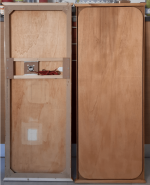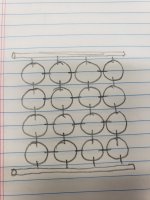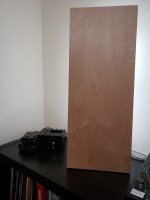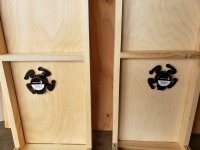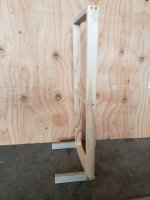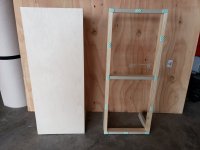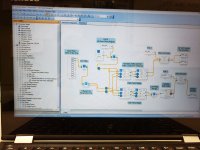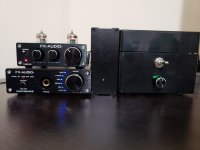dwaine --
Lead! Wow!
Some kind of out of the box thinking.
Seriously, don't let anything else I (or anyone else writes) dissuade your experimentation.
You've got to try it, if only to report back to everyone.
One never knows where it might lead ;-)
I think you'd have to try very thin lead (but then, maybe not).
It certainly bends well, but I don't imagine it recovering from fluctuations very well.
It might just contort at some scale.
You may find it too soft.
It weight might prove an issue. Bendy light-weight panels have a lot of followers.
Oddly, when I read what you wrote as, "...perhaps for bass...", I saw, ...perhaps for brass..." which got me to thinking about
French Horns.
Might prove interesting to stick an exciter on a thin piece of brass.
Separately, not certain about the holes, but you'll hear from someone.
Welcome to the exploration.
-- Andreas
Lead! Wow!
Some kind of out of the box thinking.
Seriously, don't let anything else I (or anyone else writes) dissuade your experimentation.
You've got to try it, if only to report back to everyone.
One never knows where it might lead ;-)
I think you'd have to try very thin lead (but then, maybe not).
It certainly bends well, but I don't imagine it recovering from fluctuations very well.
It might just contort at some scale.
You may find it too soft.
It weight might prove an issue. Bendy light-weight panels have a lot of followers.
Oddly, when I read what you wrote as, "...perhaps for bass...", I saw, ...perhaps for brass..." which got me to thinking about
French Horns.
Might prove interesting to stick an exciter on a thin piece of brass.
Separately, not certain about the holes, but you'll hear from someone.
Welcome to the exploration.
-- Andreas
Personally, I have always found that polystyrene foam panels sound like they are at the far end of a tunnel, i.e. the echoing sound you hear. I hope others can help you find the answer, but I have not. I have tried extruded ps (eps) and expanded ps (xps), with and without frames, with and without spines supporting the exciter, all to no avail. Various densities... With and without PVA coating. Various thickness, PS foam with wood veneer skins...foam core (PS with paper skins)....Gatorboard (PS foam with dense skins)..ps foam with plywood inserts,...all to no avail.Hi guys, new member here, experimenting with panels and different combination to eliminate that echo-y sound coming from the foam panels.
I really wish PS worked better! I used to be in the business of making PS foam myself (but not for this purpose). PS foam panels are very loud/efficient, so they are great in that respect for sure.
To be honest, I have never been able to identify (by measurements) the cause of the echo-y character of PS foam panels, They often lose output above 4 kHz to 8 kHz which may contribute, but I'm not sure if that's the real issue, or if that's just another issue.
I hope you find a solution that works for PS foam. But I suggest continuing your search for other panel materials.
I like many thin plywoods, also balsa. Currently, I'm investigating balsa with fiberglass skins, which seems very promising. PMMA (plexiglass) also sounds good. All of these produce less sound output that PS foam, but without the echo.
Generally, adding weight is a negative, except possibly in very specific locations. As for damping, I suspect you can get better effects from polymeric materials without the negatives of added weight,Has anyone tried using lead in a sheet, perhaps for bass, or in panel damping work? Anyway thx folks for this amazing work u all have done.
But don't let me stop you from trying anything you can do cheaply and safely!
Eric
Zlatko1.
I doubt that a whizzer cone will counter the large dip in the 200hz to 300hz region but .might help with the hf response.
If you are running the panel full range without a low frequency driver it will sound a little like a midrange cone driver without a low frequency drver.
I personally usually like the low end cone drivers working below 300hz to be a few dbs louder to match the energy of the panels.
a flat response always seems to me , to be a little week in the low end .
But that maybe a matter of taste.
Steve.
I doubt that a whizzer cone will counter the large dip in the 200hz to 300hz region but .might help with the hf response.
If you are running the panel full range without a low frequency driver it will sound a little like a midrange cone driver without a low frequency drver.
I personally usually like the low end cone drivers working below 300hz to be a few dbs louder to match the energy of the panels.
a flat response always seems to me , to be a little week in the low end .
But that maybe a matter of taste.
Steve.
Veleric.
I know it's only a typo but eps is expanded polystyrene and xps is extruded polystyrene.
I have not tried thick xps as I find it insulates the sound too much restricting the hf.
But I thought the 4k to 8k roll off was to do with the larger voice coils on the more powerful exciter ?
Steve.
I know it's only a typo but eps is expanded polystyrene and xps is extruded polystyrene.
I have not tried thick xps as I find it insulates the sound too much restricting the hf.
But I thought the 4k to 8k roll off was to do with the larger voice coils on the more powerful exciter ?
Steve.
Steve,I know it's only a typo but eps is expanded polystyrene and xps is extruded polystyrene.
You are being kind. I get that wrong more often than not!
Veleric.
I have posted this response a few times ,but it shows the excellent response of a bog standard 1inch thick 5ft2ft panel at 12ft distance.
the response is pretty flat from 300hz or so to 10k ,at 10k the response carries on up to 20k but at a lower level shelf.
up
https://www.audiocircle.com/index.php?action=gallery;area=browse;image=107237
It also shows the dip in the response below the 300hz point which can cause a hollow sound if run full range without a sub.
I'm not sure what you mean by an echo-y sound but there is a problem with all dml panels because the panel is always isolating the exciter from the listener.
If you are referring to the sound being distant, which I can understand especially with xps which puts a sound deadening panel between the listener and the exciter, I think of this as a wall ,especially if It is a large panel.
Eps is not so bad but i still felt the need to thin the material in front of the exciter area to a cone shape to give the panel some in room presence,or a more intimate sound let's say.
This helps give a more direct sound ,or primary sound wave.
I suppose a piezoelectric driver glued to the front of the panel might be a better way of doing things without a massive exciter in the way ?
I'm not sure but it has always been a thought of mine?
Piezos are getting more powerful every year so it could be an option in the future?
This is probably why I like the small thin veneer and card panels as they block very little of the reflections from the rear wall and radiate with very little restrictions from the front.
maybe I should make say 4 recordings of the different panels for easy comparisons and see who can tell the difference between them?
Steve.
I have posted this response a few times ,but it shows the excellent response of a bog standard 1inch thick 5ft2ft panel at 12ft distance.
the response is pretty flat from 300hz or so to 10k ,at 10k the response carries on up to 20k but at a lower level shelf.
up
https://www.audiocircle.com/index.php?action=gallery;area=browse;image=107237
It also shows the dip in the response below the 300hz point which can cause a hollow sound if run full range without a sub.
I'm not sure what you mean by an echo-y sound but there is a problem with all dml panels because the panel is always isolating the exciter from the listener.
If you are referring to the sound being distant, which I can understand especially with xps which puts a sound deadening panel between the listener and the exciter, I think of this as a wall ,especially if It is a large panel.
Eps is not so bad but i still felt the need to thin the material in front of the exciter area to a cone shape to give the panel some in room presence,or a more intimate sound let's say.
This helps give a more direct sound ,or primary sound wave.
I suppose a piezoelectric driver glued to the front of the panel might be a better way of doing things without a massive exciter in the way ?
I'm not sure but it has always been a thought of mine?
Piezos are getting more powerful every year so it could be an option in the future?
This is probably why I like the small thin veneer and card panels as they block very little of the reflections from the rear wall and radiate with very little restrictions from the front.
maybe I should make say 4 recordings of the different panels for easy comparisons and see who can tell the difference between them?
Steve.
I notice now that when you listen to a recording it plays from the site and does not download to my tablet ?
I also don't see the formats supported anymore , has this also changed ? And to what?
is anyone else the wiser ?
Steve
I also don't see the formats supported anymore , has this also changed ? And to what?
is anyone else the wiser ?
Steve
Steve,
re: your post yesterday at 2:03 PM EST
In earlier posts you demonstrated the omnidirectional output of DML panel.
Rather than, thinking a (rear mounted) exciter area of a panel or front mounting an exciter, could one just turn the panels 90 degrees to yield
re: your post yesterday at 2:03 PM EST
In earlier posts you demonstrated the omnidirectional output of DML panel.
Rather than, thinking a (rear mounted) exciter area of a panel or front mounting an exciter, could one just turn the panels 90 degrees to yield
a more direct sound ,or primary sound wave
The primary drive area is about an inch of two in front and at the back of the exciter.
But the back has a large exciter and magnet blocking the sound and distorting it.
I prefer to have all three stages of a dml panel working together.
I , primary drive.
2, primary wave.
3, dml.
Listening from the side of the panel is interesting but not ideal as the primary drive is pointing directly at the wall.
Steve.
But the back has a large exciter and magnet blocking the sound and distorting it.
I prefer to have all three stages of a dml panel working together.
I , primary drive.
2, primary wave.
3, dml.
Listening from the side of the panel is interesting but not ideal as the primary drive is pointing directly at the wall.
Steve.
It must be at least 10 years ago over on the NXT RUBBISH forum that I mentioned pointing my very large eps panels inwards but slightly toeing them out a little.
this gave a very deep Southfield that you could walk through, it was very interesting.
When the panels were facing me they gave a wall of sound impression as most of the rear wall was taken up by the panels.
While all this was very exciting the panels were far too big for my room .
In my room the smaller panels have more depth without having to toe them in.
I think it is important to match the panel size to the room size for best results.
Steve.
this gave a very deep Southfield that you could walk through, it was very interesting.
When the panels were facing me they gave a wall of sound impression as most of the rear wall was taken up by the panels.
While all this was very exciting the panels were far too big for my room .
In my room the smaller panels have more depth without having to toe them in.
I think it is important to match the panel size to the room size for best results.
Steve.
Here are a couple of pictures of a panel with a new material I have been testing out, Dibond.
It is 3mm thick with a core polyurethane and a surface of 0,3mm aluminium. This material can be bended and it still keeps its shape.
I bended it with the idea that this would increase its stiffness, while staying at the same weight.
I also "clamped" it by connecting some threaded rods to the corners and the middle. In theory if two opposite corners move outwards, the two movements should cancel each other out.
I put some bitumen damping mats on the back side of the panel. These are usualy used in cars to dampen sound. And work beautyfully to dampen some ringing I had, and to tune some resonances of the panel. On the aluminium surface the bitumen can be put on easily and removed to be moved around the panel.
The panel size is 1000mm x 748mm and I divided the distance between the exiters in height by using the golden section. Distance from top: 618, 382, 236, 145. If I make a panel that is closer to square, I tend to also use the golden section when deciding where to put the excters in width, but the shorter the width is I tend to put them closer to the center. The only change I did here was to place them close to the center in width, but not directly above another exciter.
I first hanged it from the roof and it sounded good. Then I decided to make a rib behind the exciters, which also goes thru the threaded rods, to dampen some of the vibrations in the rods.
Now it does not sound so good and I have some distortions that I can not make out where they come from.
Work in progress ...



It is 3mm thick with a core polyurethane and a surface of 0,3mm aluminium. This material can be bended and it still keeps its shape.
I bended it with the idea that this would increase its stiffness, while staying at the same weight.
I also "clamped" it by connecting some threaded rods to the corners and the middle. In theory if two opposite corners move outwards, the two movements should cancel each other out.
I put some bitumen damping mats on the back side of the panel. These are usualy used in cars to dampen sound. And work beautyfully to dampen some ringing I had, and to tune some resonances of the panel. On the aluminium surface the bitumen can be put on easily and removed to be moved around the panel.
The panel size is 1000mm x 748mm and I divided the distance between the exiters in height by using the golden section. Distance from top: 618, 382, 236, 145. If I make a panel that is closer to square, I tend to also use the golden section when deciding where to put the excters in width, but the shorter the width is I tend to put them closer to the center. The only change I did here was to place them close to the center in width, but not directly above another exciter.
I first hanged it from the roof and it sounded good. Then I decided to make a rib behind the exciters, which also goes thru the threaded rods, to dampen some of the vibrations in the rods.
Now it does not sound so good and I have some distortions that I can not make out where they come from.
Work in progress ...
Hi Giamesh
DMLs often get described as "bending wave loudspeakers".
One typically wants them free to bend rather than stiff or rigid.
I also don't follow your reasons for "clamping" the sides together with threaded rods.
I like the idea of using Dibond panels, but as they get manufactured for signage and often outdoor signage, I think the weight (thickness) of their aluminum skins may work against you.
I'd love to get panels like these with the thinest aluminum skin possible, which would give an interesting balance of bendiness and surface hardness.
I tend to follow the simplest path with these DML experiments.
Why not just try sticking a single exciter on the back of a flat Dibond panel and see what it does.
It might surprise you.
Can you explain why you think a DML will benefit from "stiffness"?I bended it with the idea that this would increase its stiffness, while staying at the same weight.
DMLs often get described as "bending wave loudspeakers".
One typically wants them free to bend rather than stiff or rigid.
I also don't follow your reasons for "clamping" the sides together with threaded rods.
I like the idea of using Dibond panels, but as they get manufactured for signage and often outdoor signage, I think the weight (thickness) of their aluminum skins may work against you.
I'd love to get panels like these with the thinest aluminum skin possible, which would give an interesting balance of bendiness and surface hardness.
I tend to follow the simplest path with these DML experiments.
Why not just try sticking a single exciter on the back of a flat Dibond panel and see what it does.
It might surprise you.
I increased the stiffness (by bending the material) based on the idea that better stiffness : mass ratio in the panel material usualy is a good thing for a DML panel. (Stiffness brings up the natural frequency / resonance of a material) I don't need to bring the resonance frequency down, since I always have been able to make DML panels of different materials, that I crossover with my sub in the 100hz area. And I find it easier to control any problems/resonances I get in the higher frequency area, compared to lower frequency.Hi Giamesh
Can you explain why you think a DML will benefit from "stiffness"?
I also don't follow your reasons for "clamping" the sides together with threaded rods.
I like the idea of using Dibond panels, but as they get manufactured for signage and often outdoor signage, I think the weight (thickness) of their aluminum skins may work against you.
I'd love to get panels like these with the thinest aluminum skin possible, which would give an interesting balance of bendiness and surface hardness.
I tend to follow the simplest path with these DML experiments.
Why not just try sticking a single exciter on the back of a flat Dibond panel and see what it does.
It might surprise you.
One of the problems I have been having with DMLs have been strong resonances close to the corners. By connecting the corners in the way I have done, a force/wave at the same frequency and power at the opposite corner, will cancel each other out. Since both push out at the same time, but also draw the opposite corner back.
I just try every material i get my hand on and try different configurations. I have tried simple and I also have tried complex....
The reason why I have more then one exciter, is because they usualy burn up and don't last long in my setup. Connecting them in series, make them last longer.
I also have them as part of a Dolby Atmos setup. I never managed to get a single DML Center under the TV to work well. But when I took the same Center signal and split it to the DML panels to the right and left of the TV, it worked better then anything else I have heard from a surround sound system in a living room.
One thing I tried that I never thought would work, was to also put the Center channel on the same panel as the stereo Right and Left. So the 4 exciters on that panel is setup thru my MiniDSP to work as a Stereo speaker when listening to music. And when looking at movies, the Center signal is routed to 2 of the exciters.
One thing I tried that I never thought would work, was to also put the Center channel on the same panel as the stereo Right and Left. So the 4 exciters on that panel is setup thru my MiniDSP to work as a Stereo speaker when listening to music. And when looking at movies, the Center signal is routed to 2 of the exciters.
I've done the same thing and posted about it within this thread (and other places).
It just seems to work.
Just part of the wonder of DMLs
Hello to all DML builders. This will be my first post!
Despite I have been in audio DIY since a while, I discovered DML thanks to this thread beginning of this year. Thanks a lot!
I would like to make one suggestion and ask for advice.
Before, for a better understanding, let me summarize where I am with DML.
I started with the topic beginning of the year to replace my tired 3 way columns.
The hazards of surfing the internet lead me to this thread. Attracted by the possibility to make my own speakers (not only the cabinet!) I started to read from the first post to the current last one the threads about DML (diyAudio, the historical Audiocircle, Part Express...). A little bit long... very instructive. I took some notes.
Even if I was septic on the possibility to reach a "good enough result", I decided to give it a try.
The first prototype was a standard home insulation 20mm XPS 1.25x0.6m, moved by an off-center Dayton Audio DAEX25FHE-4, then PVA coated and after with a white acrylic finishing. It was an encouraging try as expected, at least on the sound reproduction... my wife was not really happy with the dimensions neither with the aspects even with a paint finishing. To be elected as a main sound system, some equalization is needed.
The second prototype was a 9mm XPS 0.50x0.60m, exciter at the center. Very bad results.
The third version is a 3mm poplar plywood 0.42x1.20m on a frame with a foam suspension, an off center exciter, a spine. Excellent! We have found with them what is written in this thread : wide frequency range, good sound stage, no sweet spot effect, impressive transients, something incredibly natural in the sound... even if I think it can be improved. No need of equalization. The best feedback is from my wife who finds with this version a very good sound in a nice enough finishing for our living room. She is even proud to make demo to our friends.
So on this basis, I am coming back to the forum reading... 5 or 6 months after my 1st reading how it is difficult to find again the thread of ideas!
Here is my suggestion (for readers like me...) : would it be possible to have from the DML builders from time to time a short summary of what they have in use ? Something like "my current panel is :...". I have written below how I'd describe mine. Please ask for additional information. i think it would be good to keep the description not too long.
I am wondering now which direction to go to improve the efficiency, to extend to the bass, if possible reduce the distortion.
Then now my questions :
Thanks a lot for your feedback
My current DML realization
in use : from 2021 summer
type : standard plain membrane (not a canvas type)
membrane material : 3mm poplar plywood
dimensions (WxHxh) : 420 x 1200 x 3mm
coating : no coating
finishing : highly diluted varnish
shape detail : rounded corner
spline : yes
exciter : Dayton Audio DAEX25FHE-4
exciter gluing : original double side tape
exciter position : off center (inspired by the IEC baffle)
bandwidth : about 150Hz to 20k
mounting method : frame with foam suspension
equalization : not necessary. I think about for a fine tuning
Christian
Despite I have been in audio DIY since a while, I discovered DML thanks to this thread beginning of this year. Thanks a lot!
I would like to make one suggestion and ask for advice.
Before, for a better understanding, let me summarize where I am with DML.
I started with the topic beginning of the year to replace my tired 3 way columns.
The hazards of surfing the internet lead me to this thread. Attracted by the possibility to make my own speakers (not only the cabinet!) I started to read from the first post to the current last one the threads about DML (diyAudio, the historical Audiocircle, Part Express...). A little bit long... very instructive. I took some notes.
Even if I was septic on the possibility to reach a "good enough result", I decided to give it a try.
The first prototype was a standard home insulation 20mm XPS 1.25x0.6m, moved by an off-center Dayton Audio DAEX25FHE-4, then PVA coated and after with a white acrylic finishing. It was an encouraging try as expected, at least on the sound reproduction... my wife was not really happy with the dimensions neither with the aspects even with a paint finishing. To be elected as a main sound system, some equalization is needed.
The second prototype was a 9mm XPS 0.50x0.60m, exciter at the center. Very bad results.
The third version is a 3mm poplar plywood 0.42x1.20m on a frame with a foam suspension, an off center exciter, a spine. Excellent! We have found with them what is written in this thread : wide frequency range, good sound stage, no sweet spot effect, impressive transients, something incredibly natural in the sound... even if I think it can be improved. No need of equalization. The best feedback is from my wife who finds with this version a very good sound in a nice enough finishing for our living room. She is even proud to make demo to our friends.
So on this basis, I am coming back to the forum reading... 5 or 6 months after my 1st reading how it is difficult to find again the thread of ideas!
Here is my suggestion (for readers like me...) : would it be possible to have from the DML builders from time to time a short summary of what they have in use ? Something like "my current panel is :...". I have written below how I'd describe mine. Please ask for additional information. i think it would be good to keep the description not too long.
I am wondering now which direction to go to improve the efficiency, to extend to the bass, if possible reduce the distortion.
Then now my questions :
- Does somebody can make a feedback on the use of a thinner plywood like a 1 to 2mm birch aviation plywood?
- I already bought 0.1x1m 1mm balsa boards. What are the return on experience with balsa, not as core material but external wood ? Any advices about the overall thickness to have (I plan to keep a 0.42m wdth for the membrane), the spacing material?
- Last question (for now, sorry to be long...) : what are the experience on the bass extensions? The best choice? (classical woofer, closed box, bass reflex, open baffle, aperiodic...). The reason of this question is that my measurements shown a field sound decreasing with DML slower than a standard loudspeaker (like a line array).
Thanks a lot for your feedback
My current DML realization
in use : from 2021 summer
type : standard plain membrane (not a canvas type)
membrane material : 3mm poplar plywood
dimensions (WxHxh) : 420 x 1200 x 3mm
coating : no coating
finishing : highly diluted varnish
shape detail : rounded corner
spline : yes
exciter : Dayton Audio DAEX25FHE-4
exciter gluing : original double side tape
exciter position : off center (inspired by the IEC baffle)
bandwidth : about 150Hz to 20k
mounting method : frame with foam suspension
equalization : not necessary. I think about for a fine tuning
Christian
Attachments
Hey everyone. It's been a minute. I need to post up about my final revisions on my panels. I'm very pleased with them overall. Before that though, I have a random question.
Has anyone in here experimented with or built a DML line array with low-powered exciters rather than a high output single panel? I had an idea for like a "curtain of sound" using 16 of the 3 or 5 watt Dayton coin exciters on small 8-10" round or rounded-corner square panels either suspended from one another or mounted on a grid in a 4 x 4 pattern. Obviously with them being possibly round, and suspended, and undamped the goal would be more of a whimsical, moderate SPL, backyard party speaker design than a critical listening panel. Cool thing is you could wire them in series-parallel and push the whole mess on like 25 watts per channel. I'm thinking with that many small drivers and the right substrate you could get a nice full sound. And you could basically roll it up for storage.
You guys think this is a folly project before I buy 16 exciters and a bunch of 1/2" xps or something? 😂
Has anyone in here experimented with or built a DML line array with low-powered exciters rather than a high output single panel? I had an idea for like a "curtain of sound" using 16 of the 3 or 5 watt Dayton coin exciters on small 8-10" round or rounded-corner square panels either suspended from one another or mounted on a grid in a 4 x 4 pattern. Obviously with them being possibly round, and suspended, and undamped the goal would be more of a whimsical, moderate SPL, backyard party speaker design than a critical listening panel. Cool thing is you could wire them in series-parallel and push the whole mess on like 25 watts per channel. I'm thinking with that many small drivers and the right substrate you could get a nice full sound. And you could basically roll it up for storage.
You guys think this is a folly project before I buy 16 exciters and a bunch of 1/2" xps or something? 😂
Attachments
Hello,Has anyone in here experimented with or built a DML line array with low-powered exciters rather than a high output single panel? I
...
You guys think this is a folly project before I buy 16 exciters and a bunch of 1/2" xps or something? 😂
Experimented this kind of array no...
As every kind of array, a limitation in the highest frequencies should appear due to the geometry (the area will be like 75mm by side at the axis) and the sum of the coil mass (something like 0.26g x 16 = about 4g). The question is to predict it compare to your need.
Smaller exciter have smaller displacement and also smaller magnet. So in the overall, is this area able of at least the same efficiency and distortion. The displacement is probably a limitation.
From cost point of view, there is a ratio 3 to 6 between a coin exciter to a more powerfull one. Possible other cost balance are possible.
So why not to think about a more classical arrangement with let say 4 standard exciters, one in full range to go the treble, the 4 working in the bass.
Here, it opens a more general question to the community : among the DML builders, which arrangement is currently working? Single exciter or multi exciters like in the earliest posts?
Christian
Thanks man. I admit that even after dabbling in DMLs for about a year and a half my understanding of the finer points of the nodes is elementary at best. I know that multiple drivers can be placed on a single panel on nodes for better response but my brain wrestles with it and I've not really tried it because I presume that even if you have perfect placement the way that waves carry across the substrate you're going to encounter cancelation, and the more drivers in more places give you more opportunity to create harmonics that will eventually conflict with one another. Maybe I'm off in that thinking, or missing the bigger picture benefits, though. Anyhow, that's how I arrived at the idea of an array instead. Small panels, all single driver in close proximity but not sharing surface area or really able to cross-transmit vibration, and operating with constructive interference and frequency reinforcement. In concept it would be a pseudo 2-way system, with half the drivers running a true full range, or nearly full range with a high pass filter, and then the other half would run a shallow low pass in order to get fuller low end response overall despite the smaller drivers and surface area. Again, it was more a "fun and loud(?)" project idea that my ADHD started spontaneously running with yesterday.Hello,
Experimented this kind of array no...
As every kind of array, a limitation in the highest frequencies should appear due to the geometry (the area will be like 75mm by side at the axis) and the sum of the coil mass (something like 0.26g x 16 = about 4g). The question is to predict it compare to your need.
Smaller exciter have smaller displacement and also smaller magnet. So in the overall, is this area able of at least the same efficiency and distortion. The displacement is probably a limitation.
From cost point of view, there is a ratio 3 to 6 between a coin exciter to a more powerfull one. Possible other cost balance are possible.
So why not to think about a more classical arrangement with let say 4 standard exciters, one in full range to go the treble, the 4 working in the bass.
Here, it opens a more general question to the community : among the DML builders, which arrangement is currently working? Single exciter or multi exciters like in the earliest posts?
Christian
So after lots of experimenting, conceptualizing, failed prototypes, over- and under-designed and -thought builds, burnt exciters and wasted materials, these are what I ended up with, and I'm very pleased overall.
3mm Birch Ply, 12" x 30" surface mounted with foam tape to poplar frames. 3 thin coats of aerosol water-based poly on the Ply. Dayton DAEX25Q-4 exciters, non-reinforced, mounted on the basic 3/5, 2/5 node, powered by a custom build class AB 2x35 amplifier. I'm running them in a 2.1 configuration with a 10" velodyne sub, crossed over via a Dayton DSPB-K at 110Hz, 3rd order, with a little bit of parametric eq to smooth out the peaks and dips. A simple in-room RTA shows a nice overall response between around 90-16k, with the expected tapers beyond, but frankly less sharp than I was expecting.
I think they sound excellent. Warm, airy, but not thin, with great detail and solid imaging. They give me the sound I am looking for out of everything from jazz/vocals to electronic and metal. I found good placement in the middle of my listening space gives me excellent depth and breadth of sound while neither losing instrument/performer placement in the stage, nor being easily to locate with eyes closed. Long 20-20k sweeps show excellent response with no unsavory panel resonances anywhere in the spectrum.
I may not have achieved the potential as some of the exotic and more calculated panels from the most talented folks in this community but I get the results I wanted and then some.
3mm Birch Ply, 12" x 30" surface mounted with foam tape to poplar frames. 3 thin coats of aerosol water-based poly on the Ply. Dayton DAEX25Q-4 exciters, non-reinforced, mounted on the basic 3/5, 2/5 node, powered by a custom build class AB 2x35 amplifier. I'm running them in a 2.1 configuration with a 10" velodyne sub, crossed over via a Dayton DSPB-K at 110Hz, 3rd order, with a little bit of parametric eq to smooth out the peaks and dips. A simple in-room RTA shows a nice overall response between around 90-16k, with the expected tapers beyond, but frankly less sharp than I was expecting.
I think they sound excellent. Warm, airy, but not thin, with great detail and solid imaging. They give me the sound I am looking for out of everything from jazz/vocals to electronic and metal. I found good placement in the middle of my listening space gives me excellent depth and breadth of sound while neither losing instrument/performer placement in the stage, nor being easily to locate with eyes closed. Long 20-20k sweeps show excellent response with no unsavory panel resonances anywhere in the spectrum.
I may not have achieved the potential as some of the exotic and more calculated panels from the most talented folks in this community but I get the results I wanted and then some.
Attachments
- Home
- Loudspeakers
- Full Range
- A Study of DMLs as a Full Range Speaker
